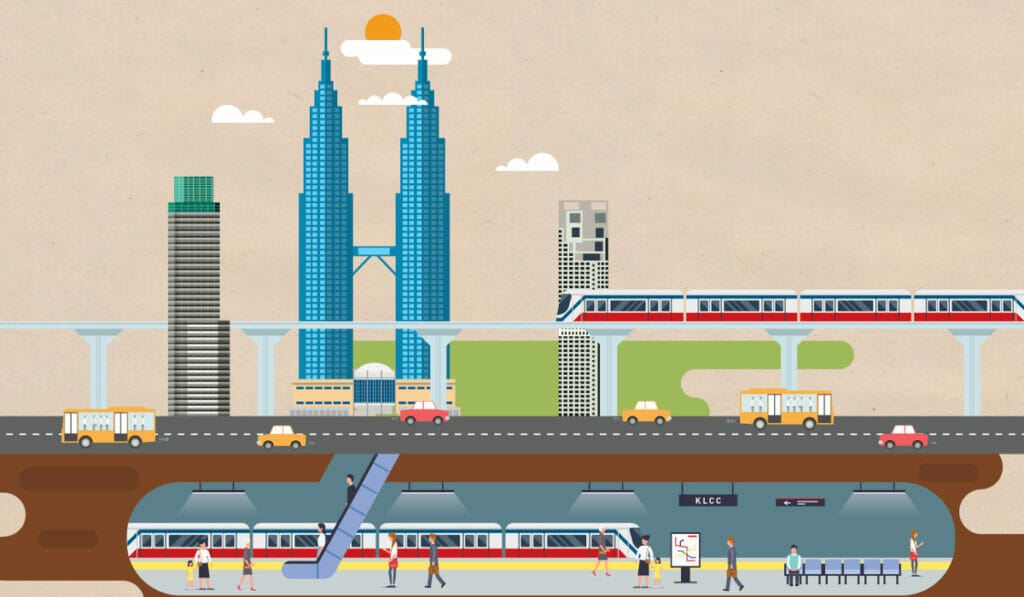
THE SOLUTION
Datuk Seri Amin Nordin names Singapore as one of the models he looks to in the effort of making Kuala Lumpur more liveable. Singapore is roughly three times bigger than Kuala Lumpur city, with a population of about 5.6 million people. But according to the numbers from the Singaporean Land Transport Authority, there were less than a million registered vehicles in 2016. That number has been pretty much stagnant for the last five years and, just to give you a comparison, in 2011, Singapore had 956,704 vehicles on its roads, while KL reported 4,914,992 vehicles in total.
This stark difference in numbers can be attributed to policy at the national level in Singapore, where quota systems, like the Certificate of Entitlement (COE), and congestion management systems, like the Electronic Road Pricing (ERP), help to dissuade car ownership in the island nation. Adversely, in Malaysia, we do have local excise duties of up to 105 per cent for cars that have an engine capacity of more than 2,500cc, but then there exists the widespread availability of affordable cars and, of course, there’s always the issue of having a National Car Company.
So, if we can’t solve the problem by reducing the number of vehicles on the road, then this is where good urban planning steps in. “A good plan should include the traffic planning into the land use plan,†explains Dr Nikmatul. Just this year, the Sungai Buloh-Kajang MRT line completed its second phase in July, bringing the total to nine rail transit lines in the Klang Valley area. With an additional LRT line and MRT line scheduled to be completed in 2020 and 2022, respectively, the Land Public Transport Commission (SPAD) targets to achieve a share of 40 per cent public transportation adoption by 2030.
To reach this goal, the mayor stresses that Kuala Lumpur City Hall (DBKL) will not be building any more parking lots inside the city centre and, instead, will be investing in multi-story parking facilities near public transportation hubs. Even within the city, it is now reviewing its planning requirement policy where it is looking to reduce the number of parking requirements “from one number for every 500 sq ft to one number for every 1,000 sq ft.†Datuk Seri Ahmad Nordin adds: “In the future, I foresee when there are developments, there will be reduced car parks. So, if you buy any condo or apartment in the city, there won’t be a space for you to park your car, so you must use public transportation.â€
Assuming everything goes to plan, there is still the need to solve the problem of the last mile. According to DBKL, from 2011 to 2014, it has added an average of 12km of pedestrian networks each year. But we still hear the constant argument against public transportation: if the stop isn’t in the direct vicinity of the destination, it’s often too uncomfortable to walk that last bit of the way. Gil Penalosa, the Director and Chair of the Board for the 8-80 Cities organisation, explains that, maybe, we have to start thinking about building walkways that puts pedestrians first. We share the same climate with our neighbours down south; and, yet, we don’t share the same argument regarding the issue of the last mile.
Dr Nikmatul tells me that, at the end of the day, city planning has to be a collaboration between city hall and the residents. “There is something called the Town and Country Planning Act 1976 and what this law states is that whenever the government outlines a structure plan for the state, it is mandatory for the local authority to hold meetings where they invite members of the public to voice their concerns.†She continues: “Every 10 to 15 years, the local plan needs to be revised. This is the time for the community to make a difference. But, unfortunately, most are not aware and, sometimes, they just don’t care.â€
So how do we drive community participation? Tina Saaby, the Chief Architect of the Municipality of Copenhagen, Denmark, says that you have to make it easy for the community to communicate with the people in power. “Then,†she says “you develop a culture.â€


